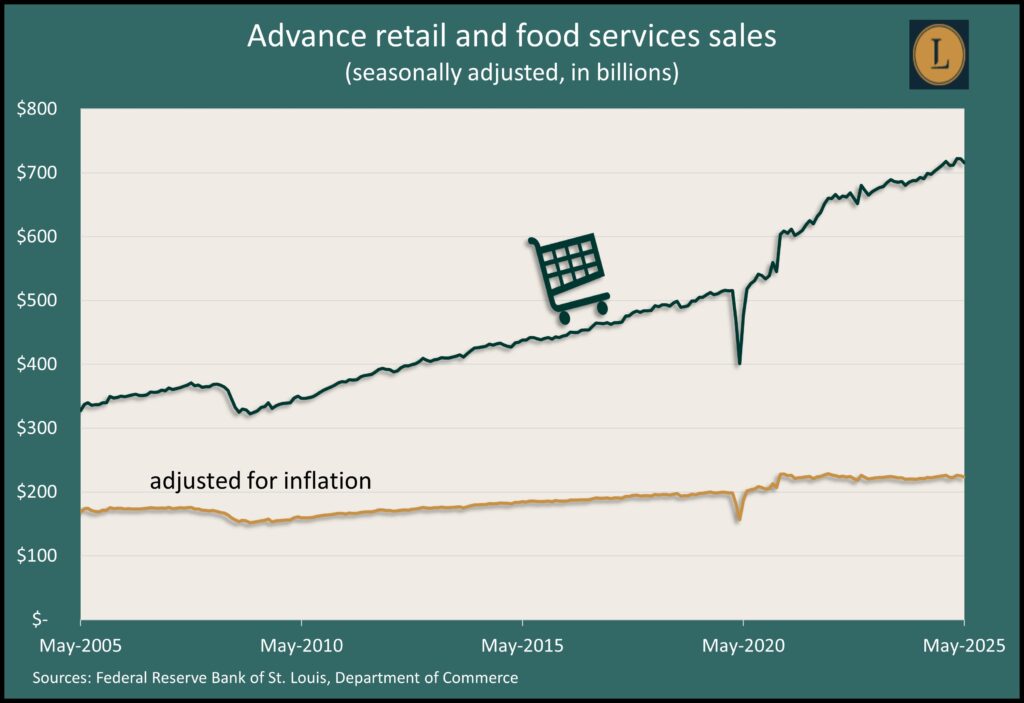Podcast: Play in new window | Download
Advisors on this week’s podcast
(with Max Hoelzl, Joel Dresang, engineered by Blake Miller)
Week in Review (June 16-20, 2025)
Significant Indicators & Reports
Monday
No major reports
Tuesday
The Commerce Department said retail sales fell 0.9% in May after dropping 0.1% in April. The back-to-back setbacks in consumer spending followed buying sprees amid anticipation of higher prices from escalated tariffs. By category, sales declined in seven of 13 retail groups, including car dealers, appliance centers and bars and restaurants. Gas station revenue also fell, though that was tied to lower gas prices. Retail sales make up two-thirds of the consumer spending that accounts for about 70% of U.S. economic activity.

U.S. industrial production sank 0.2% in May, the second drop-off in three months, according to the Federal Reserve. Manufacturing output rose slightly for the month but was offset by production declines among utilities. Car makers accounted for the bulk of increased factory production. Excluding automotive, manufacturing output fell 0.3%. Compared to May 2024, total industrial production was up a mild 0.6%. Capacity utilization, considered a leading indicator of potential inflation, fell to 77.4% in May, remaining below the long-term average of 79.6%.
Wednesday
The annual pace of housing starts and building permits slowed in May to levels not seen since the COVID-19 recession. A joint report from the departments of Commerce and Housing and Urban Development showed new construction down 10% from April’s pace while permits sank 2%. Both figures reached their lowest points since mid-2020. At the same time, the pace of houses under construction and as well as those being completed continued to slow in May, though they remained above the rates at the onset of the pandemic, which was the highest level since before the Great Recession.
The four-week moving average for initial unemployment claims reached its highest point in nearly two years. The measure of employers’ willingness to part with workers rose for the third week in a row and the seventh time in eight weeks. Still, claims were 32% below the 58-year average; they were 22% above their low just before the pandemic. The Labor Department reported more than 1.8 million Americans claimed unemployment insurance benefits in the latest week, up 4% from the week before and up 7% from the same time last year.
Thursday
Markets closed for Juneteenth Day
Friday
The Conference Board’s index of leading economic indicators fell 0.1% in May, following a downwardly revised drop of 1.4% in April. The business research group said the six-month decline of its index accelerated to 2.7% through May from 1.4% the previous month. A rebound in stock prices was one of the only bright spots in May, with measures worsening for consumer confidence, factory orders, initial unemployment claims and housing permits. The Conference Board cited higher tariffs for slower growth in gross domestic product. It forecast a 1.6% rise in GDP for 2025 and said 2026 will be lower. GDP expanded by 2.8% in 2024.
Market Closings for the Week
- Nasdaq – 19447, up 41 points or 0.2%
- Standard & Poor’s 500 – 5968, down 9 points or 0.2%
- Dow Jones Industrial – 42207, down 9 points or 0.0%
- 10-year U.S. Treasury Note – 4.38%, down 0.04 point
